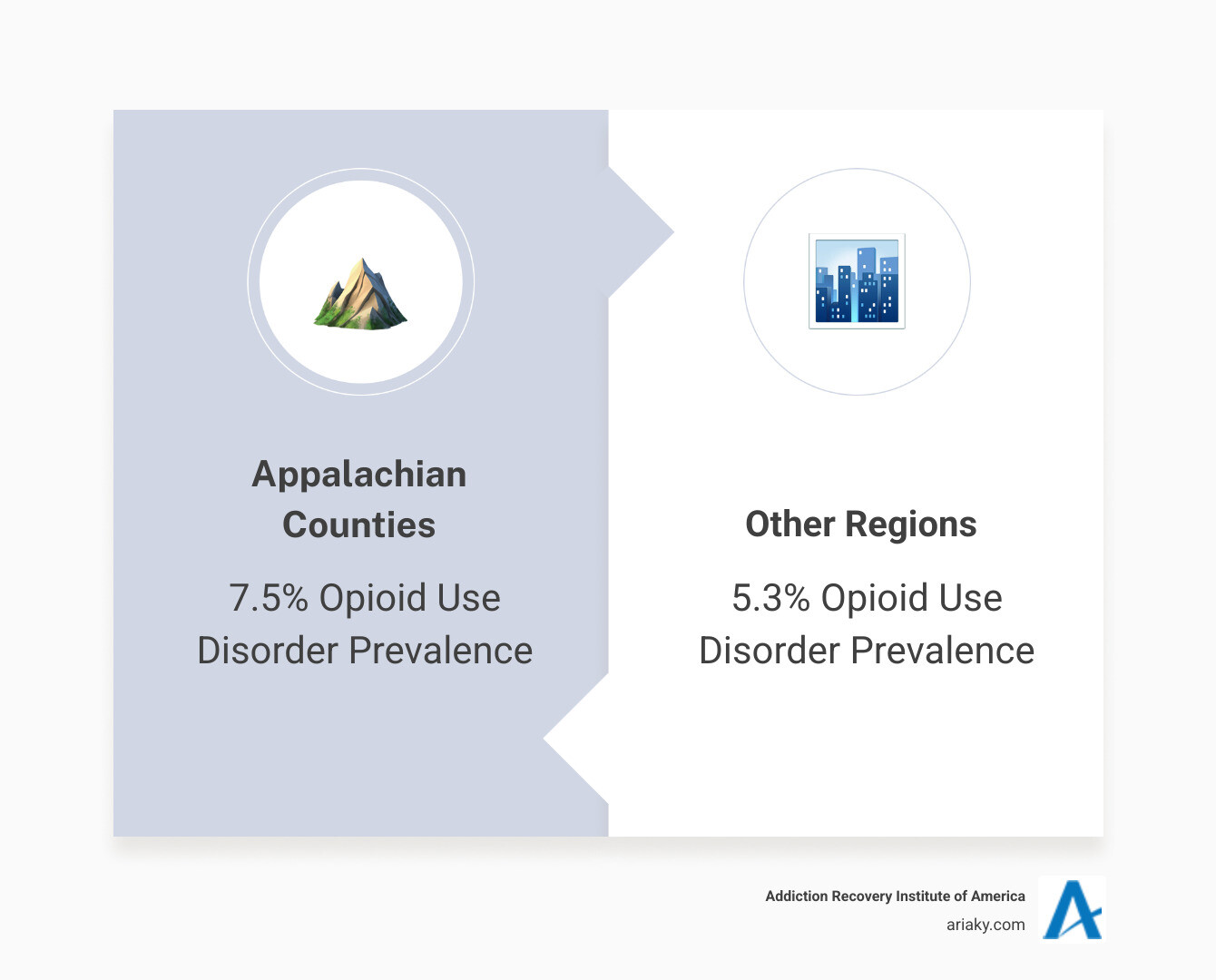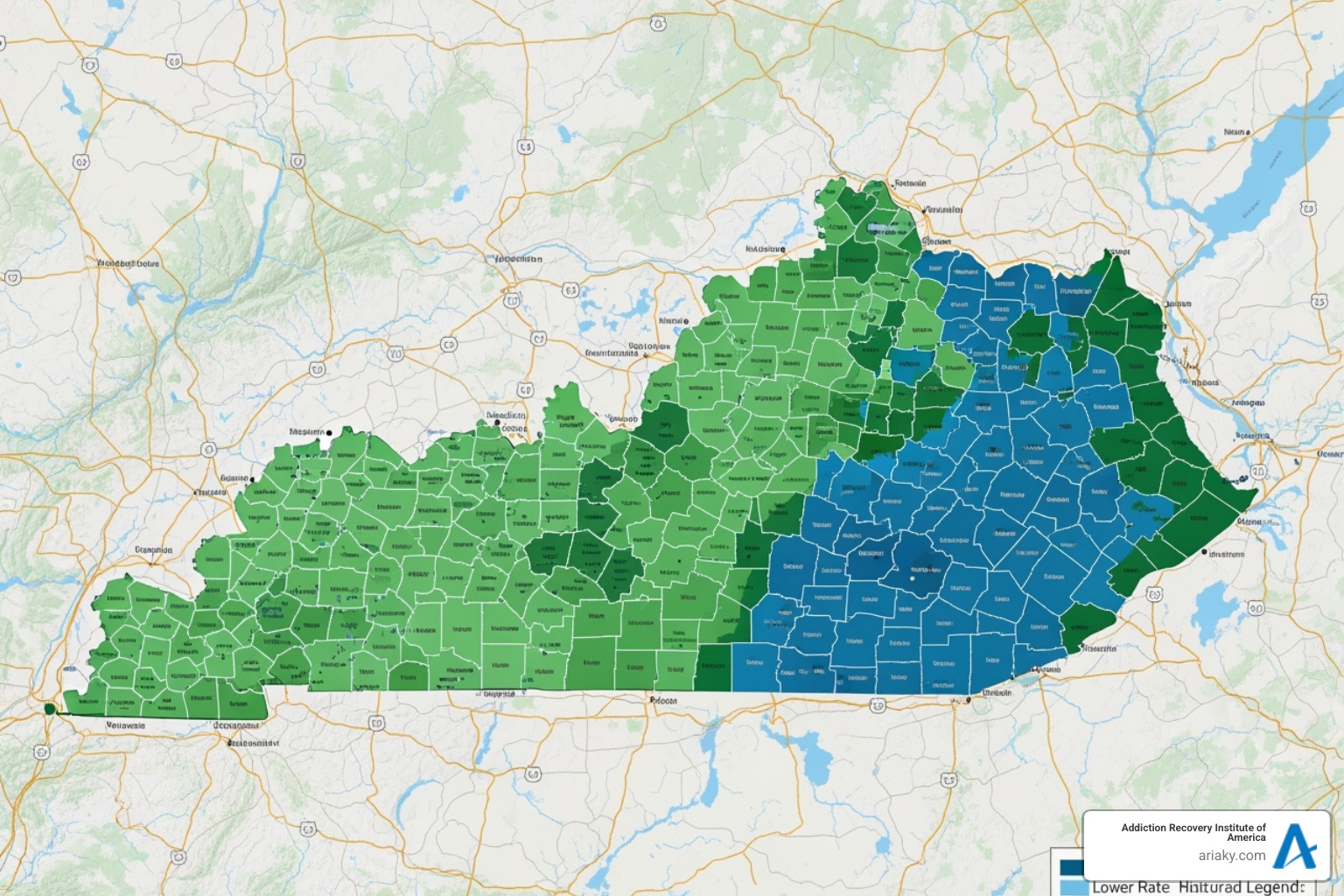Understanding the Crisis: Why Kentucky Faces America’s Most Complex Substance Abuse Challenge
Kentucky substance abuse represents one of the most pressing public health crises in America today. With the third-highest binge drinking rate nationwide and ranking 7th for overdose deaths when adjusted for population, Kentucky faces challenges that demand immediate attention and comprehensive solutions.
Key Kentucky Substance Abuse Statistics:
- 5.45% of Kentuckians struggle with Alcohol Use Disorder annually
- 70% of overdose deaths involve fentanyl
- 5.9% estimated statewide opioid use disorder prevalence (2019)
- 52,294 emergency department visits caused by drug abuse last year
- 21,998 DUI arrests in 2019
The numbers tell a sobering story, but they also reveal something important: Kentucky isn’t ignoring this crisis. The state has built an extensive network of resources, from the Kentucky Agency for Substance Abuse Policy (KY-ASAP) to specialized hotlines like KY-OAR (Kentucky Opioid Assistance and Resource Hotline).
Geography plays a crucial role in Kentucky’s substance abuse landscape. Appalachian counties show significantly higher opioid use disorder rates compared to other regions – 7.5% versus 5.3% in 2019. This disparity highlights the need for targeted, location-specific approaches to treatment and prevention.
Whether you’re seeking help for yourself or a loved one, understanding Kentucky’s substance abuse resources can be the first step toward recovery. From state-sponsored treatment programs to community support networks, Kentucky offers multiple pathways to healing.
This guide will walk you through everything you need to know about Kentucky’s substance abuse landscape – the challenges, the resources, and most importantly, the hope for lasting recovery.

The Scope of Substance Abuse in Kentucky: Statistics and Trends
The reality of Kentucky substance abuse hits close to home when you look at the numbers. Across our beautiful Commonwealth, families are struggling with both alcohol and drug addiction, while our healthcare system works overtime to respond to this crisis. These aren’t just statistics – they represent our neighbors, friends, and loved ones who need our support and understanding.

Alarming Alcohol Consumption Rates
It’s hard to talk about Kentucky without mentioning our bourbon heritage. But unfortunately, our relationship with alcohol goes beyond tradition and tourism. Kentucky has the third-highest binge drinking rate in the entire United States – a sobering fact that affects communities from the mountains to the Mississippi.
Binge drinking creates immediate dangers. When someone drinks too much too fast, they’re more likely to make risky decisions, get hurt, or hurt others. The ripple effects touch everyone around them.
The numbers get even more concerning when we look at Alcohol Use Disorder. About 5.45% of Kentuckians struggle with this condition each year. That might sound small, but it represents tens of thousands of people who can’t control their drinking despite serious consequences.
Public safety suffers too. In 2019, Kentucky law enforcement made 21,998 DUI arrests. Each arrest represents someone who got behind the wheel while impaired, putting themselves and innocent people at risk.
Some areas face bigger challenges than others. Heavy drinking in Lexington reached 19.8% of adults – the highest rate in Kentucky. When certain communities struggle more, they need extra attention and resources.
If you’re worried about alcohol use, whether for yourself or someone you care about, help is available. Our Alcohol Rehab Kentucky guide offers detailed information about treatment options. You can also explore various Alcohol Abuse Treatment approaches to find what works best.
The Opioid Epidemic and Drug Abuse Trends in Kentucky
While alcohol creates serious problems, the opioid crisis has devastated Kentucky communities for years. We’ve been fighting this battle on multiple fronts, and the statistics show just how steep the climb has been.
Kentucky has the 5th highest opioid dispensing rate in America, with 72.3 prescriptions per 100 people. Many Kentuckians first encountered opioids through legitimate medical treatment for injuries or surgeries. Unfortunately, these powerful medications can lead to dependence even when used as prescribed.
The consequences have been tragic. When you adjust for population size, Kentucky had the 7th highest number of overdose deaths in 2019. Fentanyl-related deaths now dominate these statistics, with this deadly synthetic opioid appearing in 70% of overdose deaths last year.
Our emergency departments see the crisis every day. Drug abuse caused 52,294 emergency department visits in Kentucky over the past year. That’s more than 140 visits every single day – each one representing someone in crisis.
County disparities tell an important story about how geography affects addiction. Jefferson County recorded the highest total number of fatal overdoses with 512 deaths. But when you look at rates per population, rural Knott County actually had the highest overdose rate in the state.
This difference shows how both urban and rural communities face unique challenges. Cities might have more total cases, but rural areas often struggle with limited treatment options and longer distances to care.
Understanding Substance Use Disorder requires recognizing that addiction doesn’t discriminate by zip code, income level, or background. Whether you live in Louisville or a small mountain town, recovery resources and support should be within reach.
KY-ASAP: The State’s Coordinated Response to Kentucky Substance Abuse
When Kentucky substance abuse reached crisis levels, the state knew it needed a coordinated response. That’s where the Kentucky Agency for Substance Abuse Policy (KY-ASAP) comes in. Created with a clear mission, KY-ASAP works to develop strategic plans that reduce alcohol, tobacco, and other drug use among both young people and adults across Kentucky.
What makes KY-ASAP special is how it brings everyone together. Instead of having different agencies working separately, KY-ASAP coordinates efforts between state and local organizations. This teamwork approach ensures that resources aren’t wasted and that communities get the help they need.
The agency follows a three-pronged approach that tackles the problem from every angle. First, there’s prevention – stopping substance abuse before it starts through education and community programs. Second, treatment provides compassionate care for people already struggling with addiction. Finally, law enforcement works to reduce the supply of illegal drugs and hold dealers accountable.
This comprehensive strategy recognizes something important: there’s no single solution to substance abuse. It takes prevention, treatment, and law enforcement working together to create healthier, safer communities throughout Kentucky.
How KY-ASAP is Structured for Statewide Impact
KY-ASAP was established in 2000 and later moved under the Office of Drug Control Policy in 2004. This placement shows how seriously Kentucky takes coordinating its substance abuse response.
At the top level, the KY-ASAP State Board provides oversight and guidance. Created under KRS 15A.340, this board brings together leaders from key state agencies to discuss policy issues, make recommendations, and find ways for different agencies to work together better. Think of them as the strategic planners who make sure everyone’s rowing in the same direction.
But here’s where KY-ASAP really shines: its network of local boards. 119 KY-ASAP boards cover all 120 counties in Kentucky, with seventeen operating as regional boards that serve multiple counties. These local boards are the heart of the system because they know their communities best.
Each local board conducts its own needs assessment and creates strategic plans based on what their specific area needs. A rural Appalachian county faces different challenges than downtown Louisville, so their solutions need to be different too. Many single-county boards rely entirely on KY-ASAP funding for their prevention and treatment programs, making this support absolutely critical.
These local boards have become real community leaders. They’ve implemented smoke-free policies, created youth education programs, and developed initiatives custom to their area’s specific substance abuse challenges. The State Board encourages local boards to share resources and remove barriers through interagency collaboration, making the whole system more effective.
Geographic Challenges and Targeted Analysis
Kentucky’s geography creates unique challenges in fighting substance abuse. The Appalachian region has been hit particularly hard by the opioid crisis. Economic struggles, limited healthcare access, and geographic isolation make it harder for people to get help when they need it.
Recent research has given us a clearer picture of just how serious the problem is. A sophisticated study used capture-recapture analysis to link multiple databases – including Vital Statistics, EMS records, prescription monitoring, and Medicaid data. This method gives us much more accurate numbers than traditional surveys, which often miss people due to stigma or fear.
The findings were sobering. Statewide Opioid Use Disorder prevalence was estimated at 5.5% in 2018 and 5.9% in 2019 for adults aged 18-64. But the real story is in the dramatic differences between counties – ranging from just 1.3% to a staggering 17.7%.
The Appalachian region disparities are particularly striking. Appalachian counties showed consistently higher OUD rates compared to other parts of Kentucky: 7.1% versus 4.9% in 2018 and 7.5% versus 5.3% in 2019. This data helps explain why targeted resources like our Drug Rehab Morehead KY Guide 2025 are so important for these underserved communities.
These research findings are substantially higher than previous survey estimates, showing that traditional methods were seriously underestimating the scope of the problem. Now that we have better data, KY-ASAP can direct resources more effectively to the areas that need them most.
Navigating Treatment and Recovery Resources Across the Commonwealth
Finding help for Kentucky substance abuse can feel overwhelming, but the state has developed a robust network of resources to guide individuals and families toward recovery. From initial crisis support to long-term aftercare, various options are available to meet diverse needs.
Our commitment at ARIA Kentucky is to ensure that comprehensive and compassionate care is accessible. For those seeking pathways to healing, understanding these resources is paramount. Our Addiction Treatment Kentucky guide offers a starting point for exploring these vital services.
State-Sponsored Initiatives and Helplines
Kentucky has invested significantly in creating accessible entry points for individuals seeking help. These initiatives serve as vital lifelines:
- KY HELP Statewide Call Center: For immediate assistance, we can contact our partners at the KY HELP Statewide Call Center at 1-877-318-1871. Screening and referral specialists are available Monday through Friday from 7:00 am to 10:00 pm EST/EDT, and Saturday and Sunday from 8:30 am to 5:30 pm EST/EDT.
- Kentucky Opioid Assistance and Resource Hotline (KY-OAR): For after-hours assistance or inquiries, the KY-OAR Hotline at 1-800-854-6813 provides crucial support when other services may be closed.
- FindHelpNowKY.org: This online platform is a valuable tool to find facilities and providers actively taking new clients. It’s a great starting point for individuals seeking treatment options.
- KSP Angel Initiative: This unique program allows individuals to walk into any of the 16 Kentucky State Police Posts across the Commonwealth and ask for help with substance use disorders. An “Angel” will then connect them with treatment centers and health professionals. Learn more about this compassionate initiative through Operation UNITE’s page here and the Kentucky State Police’s page here.
- Kentucky Opioid Response Effort (KORE): KORE is a significant state initiative aimed at enhancing access to treatment and recovery services, particularly for high-risk populations and areas. More detailed information can be found on the CHFS website here.
- Operation UNITE: This organization provides a toll-free Treatment Referral & Help Line at 1-866-90-UNITE (1-866-908-6483) for anyone seeking assistance or inquiring about qualifying for a UNITE Treatment Voucher. These vouchers can help cover treatment costs for low-income individuals in UNITE’s 32-county service area. Additional details on their voucher program are available here.
Types of Treatment Programs and Therapies
Once an individual decides to seek help, Kentucky offers a spectrum of evidence-based treatment programs and therapies. The choice of program often depends on the severity of the addiction, co-occurring mental health conditions, and individual needs.
- Detoxification: Often the first step, medically supervised detox helps manage withdrawal symptoms safely.
- Residential (Inpatient) Treatment: For those requiring a structured and immersive environment, residential programs offer 24/7 care, counseling, and support away from triggers.
- Partial Hospitalization Programs (PHP): PHP offers intensive treatment during the day, allowing clients to return home in the evenings. It’s a step down from residential care.
- Intensive Outpatient Programs (IOP): IOP provides a flexible treatment schedule, allowing individuals to maintain work or school commitments while receiving therapy and support several times a week. Our Kentucky IOP Regulation Guide provides further insight. For a deeper understanding of program intensity, our article on Inpatient vs Outpatient options can be helpful.
- Medication-Assisted Treatment (MAT): MAT combines FDA-approved medications (such as Buprenorphine, Methadone, and Naltrexone) with counseling and behavioral therapies. In 2019, 124 facilities in Kentucky offered MAT, serving over 10,000 clients. These medications help reduce cravings and withdrawal symptoms, supporting long-term recovery.
- Therapeutic Approaches: Common therapies include Cognitive Behavioral Therapy (CBT), Motivational Interviewing, and trauma-related counseling, which were widely offered by facilities in 2019. Individual and group counseling are foundational, offered by 97.1% and 94.2% of facilities respectively.
- Dual Diagnosis Treatment: Many individuals struggling with substance abuse also have co-occurring mental health disorders. In 2019, 193 facilities offered programs for clients with co-occurring mental and substance use disorders. This integrated approach, often referred to as Dual diagnosis, is crucial for addressing both conditions simultaneously for lasting recovery.
To find appropriate treatment facilities, the SAMHSA Behavioral Health Treatment Services Locator here is an excellent confidential resource.
Community, Housing, and Peer Support Systems
Recovery is a journey that extends beyond formal treatment. Kentucky understands the importance of ongoing support, community reintegration, and stable living environments.
- Recovery Kentucky: This innovative program, established by the Kentucky Housing Corporation and the Department of Corrections, addresses the critical link between substance abuse and homelessness. There are 13 Recovery Kentucky centers across the Commonwealth, providing housing and recovery services for up to 2,000 Kentuckians. These centers offer a safe, supportive environment where individuals can recover from addiction and gain control of their lives, eventually transitioning to permanent housing. Learn more about Recovery Kentucky’s impact here.
- After-Care Support Groups: Peer-led and professionally facilitated support groups are essential for long-term sobriety. Organizations like Alcoholics Anonymous (AA) and Narcotics Anonymous (NA) provide a sense of community, accountability, and shared experience. These groups reinforce treatment, offer emotional support, and help individuals develop coping strategies.
- Peer Support Specialists: These individuals, often in recovery themselves, provide invaluable guidance and mentorship. They offer lived experience, empathy, and practical advice, helping others steer the challenges of recovery.
- Mental Health Support: For individuals with co-occurring mental health conditions, groups like the Depression and Bipolar Support Alliance (DBSA) offer specialized support. The National Alliance on Mental Illness (NAMI)- Kentucky also provides directories and helplines for mental health resources.
Finding the right support system is a personal journey, and Kentucky’s diverse offerings ensure that everyone can find a path that resonates with their needs. For a broader view of available options, explore our guide to Rehab Centers in Kentucky.
Understanding Kentucky’s Legal Framework
When dealing with Kentucky substance abuse, understanding the legal side of things can feel overwhelming. But here’s the thing – Kentucky’s laws aren’t just about punishment. They’re designed to balance accountability with opportunities for healing and recovery.

The legal framework around substance abuse in Kentucky recognizes something important: addiction is a health issue, not just a criminal one. While there are serious consequences for drug and alcohol offenses, the state has also created pathways that prioritize treatment over incarceration when appropriate.
Drug Possession, Probation, and Drug Court
Kentucky organizes controlled substances into different drug schedules, each carrying its own set of penalties. The consequences you face depend on several factors: what type of substance it is, how much you have, and whether authorities believe you intended to sell it or just use it personally.
Simple possession might seem minor, but it can lead to substantial fines and jail time. And if you’re caught again? The penalties get much steeper with each offense. It’s a system designed to encourage people to seek help before their problems get worse.
If you’re on probation or parole, the rules become even stricter. Regular drug testing is typically required, and here’s something crucial to know: trying to cheat a drug test while on probation or parole in Kentucky is a felony. The state takes this seriously because these programs are meant to support your recovery, not enable continued substance use.
But Kentucky also offers hope through its Drug Court program. This isn’t your typical courtroom experience. Instead of focusing on punishment, Drug Court is all about getting you the help you need. It’s specifically designed for people whose crimes stem from addiction, not violent tendencies.
The program isn’t easy – it requires real commitment. Misdemeanor drug court lasts at least fifteen months, while felony drug court requires a minimum of eighteen months. During this time, you’ll receive intensive treatment, regular supervision, and ongoing support. It’s challenging, but it beats spending years in prison and gives you a real shot at turning your life around.
There’s another legal tool that families should know about: Casey’s Law. Sometimes, addiction makes it impossible for someone to make healthy decisions for themselves. Casey’s Law allows family members to petition the court for involuntary treatment, even when their loved one refuses help. It’s not an easy decision for families, but it can be a lifesaver when addiction has taken complete control.
Kentucky Alcohol Laws and DUI
Kentucky’s alcohol laws are pretty unique, and they might surprise you if you’re new to the state. Counties fall into three categories: “wet,” “dry,” or “moist.”
Dry counties don’t allow alcohol sales at all. Wet counties have full alcohol sales. Moist counties sit somewhere in between, allowing alcohol sales only in certain places or with special licenses. It’s like a patchwork quilt of alcohol regulations across the state.
Despite these varying rules, alcohol-related problems persist statewide. Those 21,998 DUI arrests in 2019 we mentioned earlier? They happened across all types of counties.
DUI penalties in Kentucky are serious business. You’re looking at hefty fines, license suspension, mandatory alcohol education programs, and possible jail time. Get caught again? The consequences get much worse. The state uses these strict penalties alongside public awareness campaigns to encourage responsible drinking.
If you’re in an area particularly affected by alcohol abuse, like Lexington, specialized help is available. Resources such as Lexington Alcohol Treatment can provide the support you need to address alcohol dependency before legal troubles compound your problems.
The bottom line? Kentucky’s legal system recognizes that Kentucky substance abuse is complex. While there are real consequences for breaking the law, there are also genuine opportunities for treatment and recovery. The goal isn’t just to punish – it’s to help people build healthier, safer lives.
Conclusion
When we look at Kentucky substance abuse, the statistics can feel overwhelming. High rates of alcohol misuse, a persistent opioid crisis, and the heartbreaking reality of overdose deaths paint a challenging picture. The geographic disparities we’ve explored – particularly in our Appalachian counties where opioid use disorder rates reach 7.5% compared to 5.3% elsewhere – show just how complex this crisis really is.
But here’s what gives us hope: Kentucky isn’t standing still in the face of these challenges. The Commonwealth has built something remarkable – a comprehensive network of resources that meets people wherever they are in their journey toward recovery.
The foundation starts with coordination. KY-ASAP’s strategic approach brings together prevention, treatment, and law enforcement efforts across 119 local boards covering 120 counties. This isn’t just bureaucracy – it’s communities taking ownership of their healing.
When crisis hits, help is just a phone call away. Whether it’s the KY HELP Statewide Call Center at 1-877-318-1871, the KY-OAR Hotline, or the compassionate KSP Angel Initiative where anyone can walk into a State Police Post and simply ask for help – these lifelines save lives every day.
Treatment options span the full spectrum of need. From medically supervised detox to residential care, from Partial Hospitalization Programs to Intensive Outpatient Programs, Kentucky offers pathways that fit different lives and circumstances. The availability of Medication-Assisted Treatment at 124 facilities, serving over 10,000 clients, shows our commitment to evidence-based care.
Recovery extends beyond clinical walls. Programs like Recovery Kentucky address the crucial link between addiction and homelessness, providing safe housing for up to 2,000 Kentuckians. Peer support groups, aftercare networks, and community resources recognize that lasting recovery happens in relationship with others.
Even our legal system offers hope. Kentucky’s Drug Court program and Casey’s Law provide alternatives to incarceration, focusing on healing rather than punishment alone.
At ARIA Kentucky, we’re proud to be part of this network of hope. As an accredited, AODE-certified addiction rehab center, we offer custom treatment programs – from detox through residential, PHP, and IOP – all focused on individualized care for lasting sobriety. We believe every person deserves compassionate, expert treatment designed specifically for their unique journey.
The truth is this: recovery is possible. It’s not always easy, and it’s rarely quick, but with Kentucky’s robust resources and dedicated professionals working together, lasting sobriety isn’t just a dream – it’s an achievable reality.
If you or someone you love is struggling, you’re not alone. Help is available, hope is real, and healing is possible.


